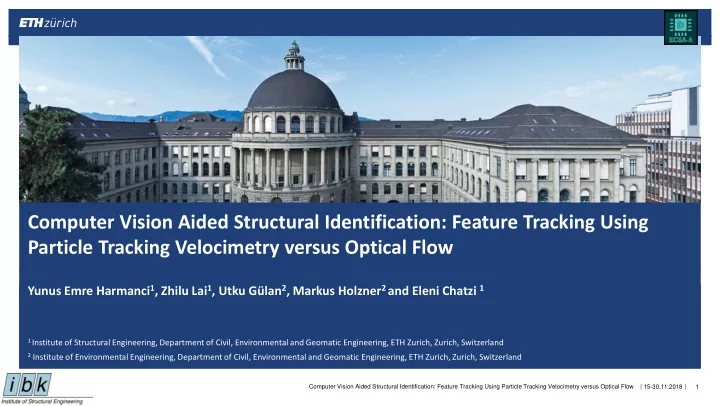

Computer Vision Aided Structural Identification: Feature Tracking Using Particle Tracking Velocimetry versus Optical Flow Yunus Emre Harmanci 1 , Zhilu Lai 1 , Utku Gülan 2 , Markus Holzner 2 and Eleni Chatzi 1 1 Institute of Structural Engineering, Department of Civil, Environmental and Geomatic Engineering, ETH Zurich, Zurich, Switzerland 2 Institute of Environmental Engineering, Department of Civil, Environmental and Geomatic Engineering, ETH Zurich, Zurich, Switzerland Computer Vision Aided Structural Identification: Feature Tracking Using Particle Tracking Velocimetry versus Optical Flow | 15-30.11.2018 | 1
Overview Introduction Methodology - Particle Tracking Velocimetry - Lucas-Kanade Method for Optical Flow - Phase-Based Motion Magnification Experimental Testing - 3-story shear frame - Reinforced concrete beam Results and Discussion Conclusions Computer Vision Aided Structural Identification: Feature Tracking Using Particle Tracking Velocimetry versus Optical Flow | | 15-30.11.2018 2
Introduction Computer vision aided structural identification and SHM - High spatial density of measurement locations - Non-contact sensing, without heavy cabling. - Easy implementation Open research problems - Changing lighting conditions - Only displacement responses are reliably extracted Focus of this work - Validation and comparison of two computer vision tracking methods for structural identification - Utilization of phase-based motion magnification for magnifying imperceptible motion in videos. Computer Vision Aided Structural Identification: Feature Tracking Using Particle Tracking Velocimetry versus Optical Flow | | 15-30.11.2018 3
Particle Tracking Velocimetry (PTV) PTV is an optical measurement technique to track Lagrangian trajectories of individual features ( particles ). - Applicable in 2D and 3D configurations. - Ability to deal with features that are not continually in the field-of-view. PTV requires high contrast features. - Background subtraction. - Introduction of artificial features (markers) onto the structure. Workflow of PTV (3D)-PTV Video Lagrangian Trajectories Gülan et al., (2012), Experimental study of aortic flow in the ascending aorta via Particle Tracking Velocimetry Computer Vision Aided Structural Identification: Feature Tracking Using Particle Tracking Velocimetry versus Optical Flow | | 15-30.11.2018 4
Lucas-Kanade Method for Optical Flow The Lucas-Kanade Method Brightness Constancy Assumption • should be invertible • Eigenvalues should not be too small • Computer Vision Aided Structural Identification: Feature Tracking Using Particle Tracking Velocimetry versus Optical Flow | | 15-30.11.2018 5
Phase-Based Motion Magnification (PBMM) on Videos Motion amplification in selected temporal frequency bands of a recorded video by modifying the local phase of the coefficients of a complex-valued steerable pyramid over time in different spatial scales and orientations. Feasibility in (lab-scale) SHM applications explored previously in 2D, and recently in 3D. Magnified Videos Original Video 5.8 Hz 5-6 Hz Frequency PBMM Content 34.4 Hz 34-35 Hz 83.3 Hz 83-84 Hz [Zimmermann et al., (2016) Structural Health Monitoring through Video Recording] Computer Vision Aided Structural Identification: Feature Tracking Using Particle Tracking Velocimetry versus Optical Flow | | 15-30.11.2018 6
Experimental Test I 3-story shear frame - mounted on a uniaxial shake table, - uniform background and artificially introduced features (2-mm markers) - scaled Northridge ground excitation and hammer impact. Video was recorded by a high-speed camera - 500 FPS - 1024 x 1024 pixel resolution - an LVDT, a laser transducer and accelerometers are used as references Test Setup Camera View Sensor Layout Computer Vision Aided Structural Identification: Feature Tracking Using Particle Tracking Velocimetry versus Optical Flow | | 15-30.11.2018 7
Experimental Test II 17.4-meter post-tensioned reinforced concrete T-beam - Irregular fore- and background - no artificial markers Sensing System - Sony RX100V with 50 fps and 1920x1080 pixel resolution - 8 uniaxial piezoelectric accelerometers along the span Sensor Layout 19 m A8 A7 A6 A5 A4 A3 A2 A1 2.2 m 2.3 m 1.3 m 0.4 m 2.2 m 2.2 m 2.3 m 2.2 m 2.2 m Computer Vision Aided Structural Identification: Feature Tracking Using Particle Tracking Velocimetry versus Optical Flow | | 15-30.11.2018 8
Results & Discussion – Shear Frame Time History Identified Modes Northridge Hammer Impact Frequency Domain Computer Vision Aided Structural Identification: Feature Tracking Using Particle Tracking Velocimetry versus Optical Flow | | 15-30.11.2018 9
Results & Discussion – Concrete Beam Motion magnified 5 times within the 1.7-1.9 Hz frequency range (First bending mode). Despite very suboptimal fore- and background, features (formwork plugs) tracked successfully, resulting in an acceptable identification of the first bending mode shape. SSI Computer Vision Aided Structural Identification: Feature Tracking Using Particle Tracking Velocimetry versus Optical Flow | | 15-30.11.2018 10
Conclusions Two tracking techniques have been employed on video recordings for computer vision aided structural identification. Comparison against LVDT and laser sensors shows that both methods perform accurately in capturing the structural displacement response. PBMM was utilized to magnify motion around the first natural frequency of the post-tensioned beam. Resolution, reliable tracking features, and lighting conditions, etc. are key factors for reliable structural response tracking. Computer Vision Aided Structural Identification: Feature Tracking Using Particle Tracking Velocimetry versus Optical Flow | | 15-30.11.2018 11
Thank you for your attention! Contact: chatzi@ibk.baug.ethz.ch Harmanci et al. (2017), High Spatial Density Vibrational Measurements via 3D ‐ Particle Tracking Velocimetry | | 11.11.2016 12
Recommend
More recommend